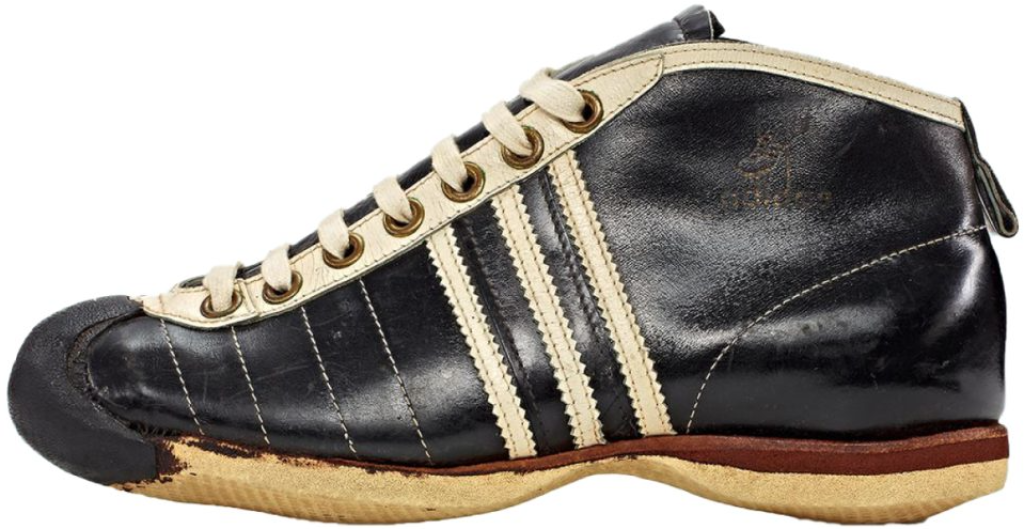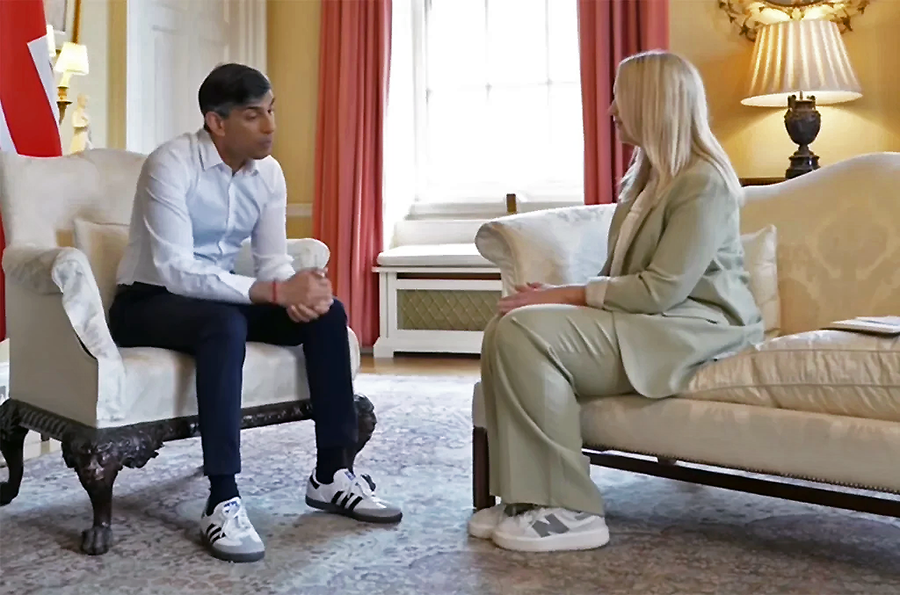With Nike on its back foot due to recent issues with the degradation of its innovation engine and Vans stumbling for the last two years from a street lifestyle position, Adidas and other brands, large and small, have an opportunity to take share and build brand mind share when it comes to sneaker culture. The runway here is a long one for brands making the right decisions about responsibly feeding the market to ensure brand and model relevance for longer.
So why does Adidas think it needs to cannibalize its iconic Samba shoe?
The headlines in the sneaker world were filled this week with a billboard proclaiming, “Adidas Plans Cheaper Versions of Popular Shoes Like the Samba” and outrage from sneaker aficionados that the brand would dare step on the toes of its iconic shoe that is perhaps the most visible Adidas shoe on the street. Purists are even bemoaning introducing the “long tongue” version of the shoe, suggesting it cuts into the OG’s version stature. But that’s a subject for another day.
The Adidas Originals Samba “is an iconic style that has captivated the hearts of global communities for over 50 years,” according to the history of the shoe published on Adidas’ U.S. site. “Contrary to popular belief, the Samba was not initially created for the World Cup or directly inspired by the Brazilian dance form. Instead, it emerged from a football game in 1950s Germany, where its exceptional performance on icy pitches earned it the nickname ‘Samba’.”

Adidas shares on its website that you can trace the Samba’s vintage roots back to the 1950s when a German team wore a “revolutionary shoe specifically designed for icy and snowy pitches.” This earlier iteration featured an outsole with three cut-out suction cups, providing players with enhanced traction and stability. Building on its success, Adidas “continued to refine and improve the Samba shoe over the years.”
The Adidas Originals Samba, as it is known today, was launched in 1972. The company states its “3-zone profile“ outsole offered unparalleled agility and multidirectional grip, perfect for fast-paced football action. The shoe also boasted soft ankle and heel padding for “optimal rearfoot protection,” while the low leather vamp in the forefoot area “facilitated excellent ball handling.”
So why take a shoe with a 50-year history and a more recent following in street culture and create a take-down in a cheaper version? Money and retailers.
It may not be a direct correlation, but anyone in the active lifestyle footwear space will from the 80s and 90s will remember the iconic Freestyle from Reebok, the shoe that put the brand on the map and pushed it to the No.1 position in the U.S. market in the 1980s, a run that lasted until the end of the decade when Nike surpassed it. Instead of protecting the shoe, which the company created in a low and hi-top version, Reebok succumbed to calls from mid-tier retailers, family footwear and its own sales force for a version they could sell more widely.
Enter the Reebok Princess, an all-leather take-down of the Reebok Freestyle that retailed at $39.95 but was actually retailing at $29.95 and promoted heavily as a loss leader at $24.95 by Sears, Mervyn’s, JC Penney, Shoe Show, Rack Room, and others in the mid-tier and family footwear channels. The release of the Princess was part of a segmentation strategy, but it went awry as the Freestyle essentially disappeared from the landscape as other, more technical fitness shoes took over. Price soon became a central theme for the Reebok brand as Sunday flyers and billboards shouted the shoe’s cheap price across the consumer marketplace. Reebok = Low Price. Many will argue that the brand never recovered.
There are no early indications that the Adidas brand will see the same fate, become the price leader, and survive, but why mess with a known commodity instead of evolving the original to see to marketplace needs?
Some key voices in the active lifestyle footwear space even argue with great accuracy that the practice of a take-down, or self knock-off is standard practice in the sneaker market. Others argue that Reebok’s move with the Princess was a defensive move as LA Gear was already (allegedly) knocking off the Freestyle.
“This is really nothing new,” said leading active lifestyle industry analyst and advisor Matt Powell. Brands have offered takedownsof their best styles in the mid-market for years, What’s different is saying the quiet part out loud.”
Powell said this can be a very successful strategy if the market is properly managed.
“For instance, the beginning of Vans’ troubles started when the takedowns became bigger than the up market product.”
Adidas held its Annual General Meeting on May 16, but the active lifestyle market only discussed initiatives or news from the meeting of the Samba take-down idea.
Company CEO Bjorn Gulden reported during the meeting that Adidas would launch cheaper versions of its three-striped shoes, including the Samba, as the company aims to “spread the trend.”
“It’s important to understand that not everyone can afford to buy a shoe for 120 or 150 [dollars], but everyone wants to take part in the same trends,“ Gulden told investors.
As reported broadly across the market, Gulden presented that Adidas will offer similar versions of the Samba and other shoes in the company’s line for $60 to $80, more affordable entry points than the $100 to $150 price tag for its main shoe lines.
“What we do at the top, 100 [dollars] and higher, we’re bringing that down. So, for Foot Locker, for Intersport and for Deichmann, we’ve also got something to offer,“ Gulden said.
What may surprise many are the retailers Adidas plans to distribute the lower-priced shoes to when launched. Deichmann, represented by its Rack Room subsidiary in the U.S., makes sense in the family footwear space, but including Foot Locker on this list is a dangerous move due to its prominence in the street lifestyle space.
Does this mean they pull the Samba from those who receive the take-down? The Original won’t last long at that price differential. And what of Dick’s Sporting Goods, Academy and Hibbett? The consumer can already buy the Samba at $80 to $100 at those stores.
Does this mean a Samba take-down at $59.95 every day and promoted at $49.95? Say it isn’t so.
Visuals Matter

British Prime Minister Rishi Sunak didn’t do the Adidas brand any favors trying to be hip while sporting Samba sneakers during a recent Instagram interview with financial influencer Abigail Foster on April 4. Reports said Sanuk “triggered a fashion backlash,” leading to accusations that he had ruined the shoe’s credibility.
UK newspaper, The Telegraph, speculated that the Prime Minister’s footwear choices also appear to have hurt sales, with spending on the iconic shoe dropping in the UK market weeks after Sunak’s interview. The Telegraph cited figures from the payments app Klarna that show that Adidas Samba sales in Britain fell 11 percent in April compared to the prior month. By comparison, total sales of Adidas trainers rose 11 percent in April, fueled by a 13 percent increase in purchases of Adidas Stan Smith trainers.
The Telegraph said that sales of Adidas Gazelle trainers, recently worn by Labour Leader Sir Keir Starmer, rose 34 percent in April; however, The media outlet did admit that the Starmer was not pictured wearing a blue pair of Gazelles until late April, so was unlikely to have had a significant impact on the month’s sales.
Meanwhile, spending on the New Balance CT302 worn by Abigail Foster during an IG interview rose by 27 percent. The spending data covers purchases with Klarna, the buy-now-pay-later service used by Adidas and other online retailers, boasting around 18 million users in the UK.
Prime Minister Rishi Sunak apologized to Samba wearers who were put off by his sartorial choices days after a video of the interview surfaced, claiming he has been a long-time devotee of the trainer.
“I issue a fulsome apology to the Samba community,“ Sunak stated on LBC Radio. “But, in my defense, I would say I have been wearing Adidas trainers, including Sambas and others, in fact, for many, many years.“
British GQ magazine said the Prime Minister “took an eternally cool sneaker and ruined it for everyone,” as it pleaded with future leaders to “stay away from our sneakers.”
Adidas had previously stated that sales of its Samba and Gazelle trainers were “very strong and growing“ in the first three months of the year before the Prime Minister wore the Sambas in the video.
Even CNN got in on the fun, reporting, “It’s been deemed the end of Adidas Sambas. Once hailed as the favorite shoe of Harry Styles, Kaia Gerber, Bella Hadid, Paul Mescal, and even Rihanna, to name a few, it’s now apparently all over for the 1950s three-striped sneaker. Why? Because UK Prime Minister Rishi Sunak was seen wearing a pair.”
Give that man a take-down.
Images courtesy Adidas, @rishisunakmp/Instagram
















